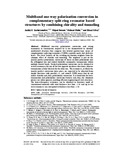Mostrar el registro sencillo del ítem
Multiband one-way polarization conversion in complementary split-ring resonator based structures by combining chirality and tunneling
| dc.creator | Serebryannikov, Andriy E. | es_ES |
| dc.creator | Beruete Díaz, Miguel | es_ES |
| dc.creator | Mutlu, Mehmet | es_ES |
| dc.creator | Ozbay, Ekmel | es_ES |
| dc.date.accessioned | 2018-10-23T07:35:29Z | |
| dc.date.available | 2018-10-23T07:35:29Z | |
| dc.date.issued | 2015 | |
| dc.identifier.issn | 1094-4087 (Electronic) | |
| dc.identifier.uri | https://hdl.handle.net/2454/31112 | |
| dc.description.abstract | Multiband one-way polarization conversion and strong asymmetry in transmission inspired by it are demonstrated in ultrathin sandwiched structures that comprise two twisted aperture-type arrays of complementary split-ring resonators (CSRRs), metallic mesh, and dielectric layers. The basic features of the resulting mechanism originate from the common effect of chirality and tunneling. The emphasis is put on the (nearly) perfect polarization conversion of linear incident polarization into the orthogonal one and related diodelike asymmetric transmission within multiple narrow bands. Desired polarization conversion can be obtained at several resonances for one of the two opposite incidence directions, whereas transmission is fully blocked for the other one. The resonances, at which the (nearly) perfect conversion takes place, are expected to be inherited from similar structures with parallel, i.e., not rotated CSRR arrays that do not enable chirality and, thus, polarization conversion. It is found that the basic transmission and polarization conversion features and, thus, the dominant physics are rather general, enabling efficient engineering of such structures. The lowest-frequency resonance can be obtained in structures made of conventional materials with total thickness less than λ 50/ and up to ten such resonances can correspond to thickness less than λ 20/ . | en |
| dc.description.sponsorship | This work is supported by the projects DPT-HAMIT, ESF-EPIGRAT, and NATO-SET-181, by TUBITAK under Project Nos., 107A004, 109A015, 109E301, and 110T306, and by Spanish Government under contract Consolider Engineering Metamaterials CSD2008-00066 and Contract No. TEC2011-28664-C02-01. Contribution of A.E.S. has partially been supported by TUBITAK in the framework of the Visiting Reseracher programme and by ESF in the framework of RNP Newfocus. M.B. acknowledges funding by the Spanish Government under the research contract program Ramón y Cajal RYC-2011-0822. E.O. acknowledges partial support from the Turkish Academy of Sciences. | en |
| dc.format.extent | 13 p. | |
| dc.format.mimetype | application/pdf | en |
| dc.language.iso | eng | en |
| dc.publisher | Optical Society of America | en |
| dc.relation.ispartof | Optics Express, Vol. 23, Issue 10, pp. 13517-13529 (2015) | en |
| dc.rights | © 2015 Optical Society of America. Users may use, reuse, and build upon the article, or use the article for text or data mining, so long as such uses are for non-commercial purposes and appropriate attribution is maintained. All other rights are reserved. | en |
| dc.subject | Multiband one-way polarization conversion | en |
| dc.subject | Complementary split-ring resonators | en |
| dc.subject | Chirality | en |
| dc.subject | Tunneling | en |
| dc.title | Multiband one-way polarization conversion in complementary split-ring resonator based structures by combining chirality and tunneling | en |
| dc.type | info:eu-repo/semantics/article | en |
| dc.type | Artículo / Artikulua | es |
| dc.contributor.department | Ingeniería Eléctrica y Electrónica | es_ES |
| dc.contributor.department | Ingeniaritza Elektrikoa eta Elektronikoa | eu |
| dc.rights.accessRights | info:eu-repo/semantics/openAccess | en |
| dc.rights.accessRights | Acceso abierto / Sarbide irekia | es |
| dc.identifier.doi | 10.1364/OE.23.013517 | |
| dc.relation.projectID | info:eu-repo/grantAgreement/MICINN//TEC2011-28664-C02-01/ES/ | en |
| dc.relation.publisherversion | https://doi.org/10.1364/OE.23.013517 | |
| dc.type.version | info:eu-repo/semantics/publishedVersion | en |
| dc.type.version | Versión publicada / Argitaratu den bertsioa | es |


